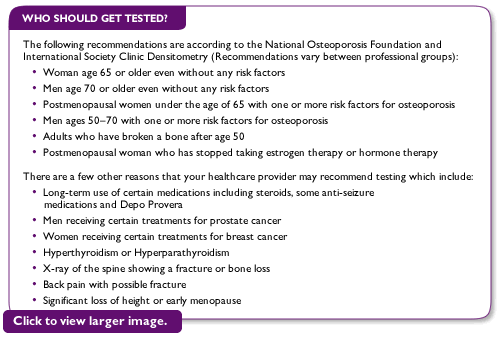Osteoporosis: Signs, Screening & Prevention
Steven Steinmetz, MD
Family Practice
Family Health Associates
Chippewa Falls
Osteoporosis, which means "porous bone," is a disease in which the quality and thickness of bone are both reduced. As the quality and thickness of bone decreases it becomes weak and brittle, which increases the chance of fractures. The most common fractures associated with osteoporosis occur at the hip, spine and wrist. Unfortunately, there often are no symptoms of osteoporosis until the first fracture occurs. Currently, there are an estimated 10 million Americans with osteoporosis (8 million women, 2 million men). There are another 34 million Americans that have a low bone mass, otherwise known as osteopenia. Osteoporosis can affect all people regardless of their ethnic backgrounds.
What causes osteoporosis?
Bones in your body are continuously being broken down and rebuilt, in a process called remodeling. When you are young, the remodeling process makes new bone faster than old bone is being broken down, this increases bone mass. In most individuals the peak bone mass occurs sometime in his/her mid-30’s. After that peak, bones slowly lose density over time. Unfortunately for women, the rate of bone loss speeds up after menopause due to a decrease in estrogen levels.
Who is at increased risk for osteoporosis?
Risks include: female gender, older age, family history of osteoporosis, history of broken bones, being small and thin, certain race/ethnicity, inactive lifestyle, smoking, excessive alcohol and certain diseases such as: eating disorders, GI disorders and rheumatoid arthritis. A diet low in calcium or vitamin D can also increase your risk of osteoporosis.
Screening
Screening is usually done with a bone density test called a DEXA (dual energy x-ray absorptiometry) which is used to measure the density of the bones at the hip, wrist and spine. You will hear the physician talk about T-score in relationship to the DEXA scan. T-score between +1 and -1 is considered normal bone density; between -1 and -2.5 is low bone density or osteopenia: between -2.5 or lower—indicates osteoporosis.

Prevention of osteoporosis
Women before menopause and those taking estrogen after menopause should take 1,000 mg of calcium a day along with 800 IU of vitamin D. Woman who are not taking hormone therapy after menopause should take 1,500 mg element of calcium and at least 800 IU of vitamin D daily (Men older than 65 are also recommended to take this amount).
Good sources of calcium include nonfat and low fat dairy products, dried beans, sardines, broccoli, soy and oat products, cereals and juices with added vitamin D. Other things that are important to help prevent bone loss include exercise, limiting caffeine, avoiding excessive alcohol use and stopping smoking.
Medications
Medications that are used in osteoporosis include calcitonin, alendronate (Fosamax), risedronate (Actonel), raloxifene (Avista), ibandronate sodium(Boniva), teriparatide (Forteo). Hormone therapy is another option but there are increased risk when taking hormone therapy which include heart disease, blood clots, strokes and breast cancer. Due to these risks you need to discuss taking hormones with your physician.
Just remember that a healthy diet, exercise, weight training, good posture and a daily multivitamin with calcium and vitamin D are some of the simple things that you can do to help decrease the chances of developing osteoporosis.
Visit the following websites for further information:
Screening & Prevention — www.uptodate.com
National Osteoporosis Foundation — www.nof.org
Osteoporosis — www.mayoclinic.com
American Academy of Family Practice — www.aafp.org
Dr. Steinmetz – Family Health Associates
For information or to schedule an appointment:
715-723-9138 | www.oakleafmedical.com
Dr. Steinmetz sees patients in Chippewa Falls.





 © 2009 OakLeaf Medical Network and OakLeaf Surgical Hospital. All rights reserved.
© 2009 OakLeaf Medical Network and OakLeaf Surgical Hospital. All rights reserved.